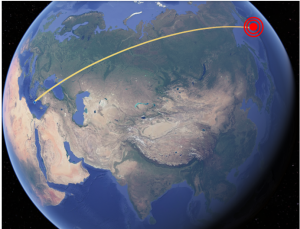Global scale event detection using the optical fiber communications network.
Kamchatka earthquakes were detected in Mediterranean sub-sea optical communication fibers
L'AQUILA, ITALY, October 15, 2025 /EINPresswire.com/ -- The recent earthquakes in Kamchatka, northeastern Russia were detected in Mediterranean sub-sea optical communication fibers, demonstrating the incredible sensitivity of this new sensing technique to monitor distant events.
Using the deployed global optical fiber network, the University of L’Aquila in collaboration with Sparkle, the University of Padova and Nokia Germany have been able to sense seismic events in the Sea of Okhotsk, more than 9,000 km away from the deployed fiber. The research team was also able to observe a clear resonance in the data about 20 days before the earthquake occurred, which are interpreted as a precursor of the seismic event. Similar resonances were also detected in subsequent seismic events in the same geographic area.
The technology involves joint communication and sensing, making use of commercial transponders from Nokia installed on a Sparkle submarine link. In contrast to several previous techniques that have involved dedicated sensing fibers, this approach only involved the post-processing of the data from the existing telemetry with no interruption or security compromise of communication services.
No other precursors to these events were so evident and their detection at a distance of more than 9,000 km is a remarkable demonstration of how the installed undersea optical communication network could be used as a worldwide sensor network. The group now proposes to work on understanding how the technology might, in the future, be able to geo-localise seismic events and their precursors.
The study has been presented at ECOC 2025, the leading European Conference in Optical Communications. Full details of the study are available in Optica Open, “Observation of Precursor of the Kamchatka Earthquake by Monitoring an Optical Fiber Link in the Mediterranean Sea” https://doi.org/10.1364/opticaopen.30273163.v1
About ECSTATIC
The EU-funded ECSTATIC project aims to harness this vast existing network by developing a ground breaking interferometry- and polarisation-based approach to vibration and acoustic fibre-optic sensing.
Follow all the developments of the ECSTATIC project on LinkedIn: https://www.linkedin.com/company/ecstatic-project/posts/?feedView=all
This project has received funding from the European Union’s Horizon Europe Framework Programme under Grant Agreement No 101189595
ECSTATIC Project
MODUS Research & Innovation
ecstatic@modus.ltd
Visit us on social media:
LinkedIn
Legal Disclaimer:
EIN Presswire provides this news content "as is" without warranty of any kind. We do not accept any responsibility or liability for the accuracy, content, images, videos, licenses, completeness, legality, or reliability of the information contained in this article. If you have any complaints or copyright issues related to this article, kindly contact the author above.
